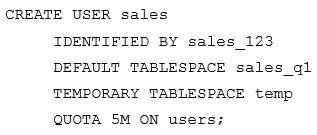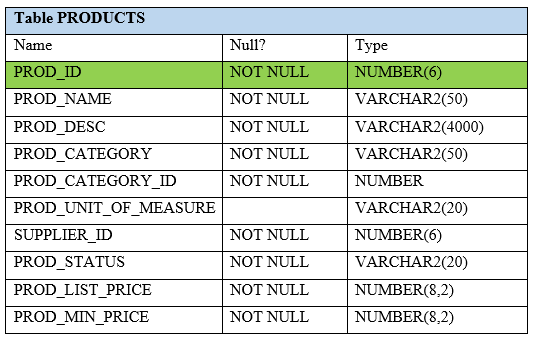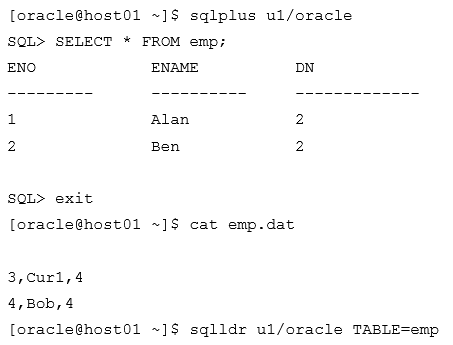oracle 1z0-082 practice test
Oracle Database Administration I Exam
Last exam update: Jun 29 ,2025
Question 1
You execute this query:
SELECT TO_CHAR(NEXT_DAY(LAST_DAY(SYSDATE), MON), dd Monday for fmMonth rrrr)
What is the result?
- A. Data block headers contain their own Data Block Address (DBA)
- A. It executes successfully but does not return any result
- B. A table row piece can be chained across several database blocks
- B. It returns the date for the first Monday of the next month
- C. Multiple row pieces from the same row may be stored in different database blocks
- C. It generates an error
- D. Multiple row pieces from the same row may be stored in the same block
- D. It returns the date for the last Monday of the current month
- E. Data block free space is always contiguous in the middle of the block
- F. Index block free space is always contiguous in the middle of the block
Answer:
B
Question 2
Which two tasks can you perform using DBCA for databases? (Choose two.)
- A. CONCAT (qty_sold, invoice_date) : requires explicit conversion
- A. Configure a nonstandard block size for a new database
- B. invoice_date = ’15-march-2019’ : uses implicit conversion
- B. Register a new database with an available Enterprise Manager Management server
- C. invoie_date > ’01-02-2019’ : uses implicit conversion
- C. Change the standard block size of an existing database
- D. qty_sold BETWEEN ‘101’ AND ’110’ : uses implicit conversion
- D. Configure incremental backups for a new database
- E. qty_sold = ‘0554982’ uses implicit conversion
- E. Enable flashback database for an existing database
Answer:
AB
Explanation:
Reference:
https://docs.oracle.com/cd/B16254_01/doc/server.102/b14196/install003.htm
Question 3
Which three statements are true about the Oracle join and ANSI join syntax? (Choose three.)
- A. The sales user must have a quota on the TEMP tablespace
- A. The Oracle join syntax supports creation of a Cartesian product of two tables
- B. The sales user must have a quota on the SALES_Q1 tablespace to hold the initial extends of all tables they plan to create in their schema
- B. The Oracle join syntax performs better than the SQL:1999 compliant ANSI join syntax
- C. The sales user must have been granted the CREATE SESSION privilege
- C. The SQL:1999 compliant ANSI join syntax supports natural joins
- D. The sales user must have their quota on the users tablespace removed
- D. The SQL:1999 compliant ANSI join syntax supports creation of a Cartesian product of two tables
- E. The sales user must have a quota on the SALES_Q1 tablespace to hold all the rows to be inserted into any table in their schema
- E. The Oracle join syntax only supports right outer joins
- F. The sales user must have been granted the CREATE TABLE privilege
- F. The Oracle join syntax supports natural joins
- G. The Oracle join syntax performs less well than the SQL:1999 compliant ANSI join syntax
Answer:
ACD
Explanation:
https://oracle-base.com/articles/9i/ansi-iso-sql-support
Question 4
Which three statements are true about external tables in Oracle 18c and later releases? (Choose
three.)
- A. A table can have only one primary key but multiple foreign keys
- A. External table files can be used for other external tables in a different database
- B. A table can have only one primary key and one foreign key
- B. The ORACLE_LOADER access driver can be used to unload data from a database into an external table
- C. The foreign key columns and parent table primary key columns must have the same names
- C. The ORACLE_DATAPUMP access driver can be used to unload data from a database into an external table
- D. It is possible for child rows that have a foreign key to remain in the child table at the time the parent row is deleted
- D. They cannot be partitioned
- E. It is possible for child rows that have a foreign key to be deleted automatically from the child table at the time the parent row is deleted
- E. The ORACLE_DATAPUMP access driver can be used to load data into a database from an external table
- F. Only the primary key can be defined at the column and table level
- F. They support UPDATEs but not INSERTs and DELETEs
- G. Primary key and foreign key constraints can be defined at both the column and table level
Answer:
A,B,C
Explanation:
https://docs.oracle.com/en/database/oracle/oracle-database/18/admin/managing-tables.html#GUID-F6948F0E-0557-4C42-9145-1897DE974CC3
Question 5
Examine the description of the BOOKS table:
The table has 100 rows.
Examine this sequence of statements issued in a new session:
INSERT INTO books VALUES (ADV112, Adventures of Tom Sawyer, NULL, NULL);
SAVEPOINT a;
DELETE FROM books;
ROLLBACK TO SAVEPOINT a;
ROLLBACK;
Which two statements are true? (Choose two.)
- A. It is not possible to shrink either indexes or Index Organized Tables (IOTs)
- A. The second ROLLBACK command does nothing
- B. It always eliminates all migrated rows if any exist in the table
- B. The second ROLLBACK command replays the delete
- C. To shrink a table it must have a PRIMARY KEY constraint
- C. The first ROLLBACK command restores the 101 rows that were deleted, leaving the inserted row still to be committed
- D. To shrink a table it must have a UNIQUE KEY constraint
- D. The second ROLLBACK command undoes the insert
- E. To shrink a table it must have row movement enabled
- E. The first ROLLBACK command restores the 101 rows that were deleted and commits the inserted row
- F. It must be in a tablespace that uses Automatic Segment Space Management (ASSM)
Answer:
CD
Question 6
Which three statements are true about table data storage in an Oracle Database? (Choose three.)
- A. Display the number of products whose PROD_LIST_PRICE is more than the average PROD_LIST_PRICE
- A. Data block headers contain their own Data Block Address (DBA)
- B. Display suppliers whose PROD_LIST_PRICE is less than 1000
- B. A table row piece can be chained across several database blocks
- C. Display products whose PROD_MIN_PRICE is more than the average PROD_LIST_PRICE of all products, and whose status is orderable
- C. Multiple row pieces from the same row may be stored in different database blocks
- D. Display the total number of products supplied by supplier 102 which have a product status of obsolete
- D. Multiple row pieces from the same row may be stored in the same block
- E. Display the minimum PROD_LIST_PRICE for each product status
- E. Data block free space is always contiguous in the middle of the block
- F. Index block free space is always contiguous in the middle of the block
Answer:
ABC
Explanation:
Reference:
https://antognini.ch/2016/10/whats-the-difference-between-row-migration-and-row-chaining/
Question 7
The SALES_Q1 and USERS tablespaces exist in one of your databases and TEMP is a temporary
tablespace.
Segment creation is not deferred.
You execute this command:
Which three statements must be true so that the SALES user can create tables in SALES_Q1? (Choose
three.)
- A. Add a data file to DATA
- A. The sales user must have a quota on the TEMP tablespace
- B. Drop other U1 objects in DATA
- B. The sales user must have a quota on the SALES_Q1 tablespace to hold the initial extends of all tables they plan to create in their schema
- C. Increase U1’s quota sufficiently in DATA
- C. The sales user must have been granted the CREATE SESSION privilege
- D. Set DEFERRED_SEGMENT_CREATION to TRUE
- D. The sales user must have their quota on the users tablespace removed
- E. Grant UNLIMITED TABLESPACE to U1
- E. The sales user must have a quota on the SALES_Q1 tablespace to hold all the rows to be inserted into any table in their schema
- F. Set AUTOEXTEND ON for data files in DATA
- F. The sales user must have been granted the CREATE TABLE privilege
Answer:
B,D,F
Question 8
View the Exhibit and examine the structure of the PRODUCTS table.
Which two tasks require subqueries? (Choose two.)
- A. Oracle Managed Files (OMF)
- A. Display the number of products whose PROD_LIST_PRICE is more than the average PROD_LIST_PRICE
- B. Online table segment shrink
- B. Display suppliers whose PROD_LIST_PRICE is less than 1000
- C. Online index segment shrink
- C. Display products whose PROD_MIN_PRICE is more than the average PROD_LIST_PRICE of all products, and whose status is orderable
- D. Automatic data file extension (AUTOEXTEND)
- D. Display the total number of products supplied by supplier 102 which have a product status of obsolete
- E. Capacity planning growth reports based on historical data in the Automatic Workload Repository (AWR)
- E. Display the minimum PROD_LIST_PRICE for each product status
Answer:
A,C
Question 9
Which three statements are true about Oracle synonyms? (Choose three.)
- A. Table aliases can improve performance
- A. A synonym cannot be created for a PL/SQL package
- B. The BETWEEN condition always performs better than using the >= and <= conditions
- B. A synonym can be available to all users
- C. The join syntax used makes no difference to performance
- C. A SEQUENCE can have a synonym
- D. The BETWEEN condition always performs less well than using the >= and <= conditions
- D. A synonym created by one user can refer to an object belonging to another user
- E. The Oracle join syntax performs better than the SQL:1999 compliant ANSI join syntax
- E. Any user can drop a PUBLIC synonym
Answer:
B,C,D
Explanation:
Reference:
https://docs.oracle.com/cd/B19306_01/server.102/b14200/statements_7001.htm
Question 10
Which three statements are true regarding indexes? (Choose three.)
- A. SELECT emp_id, ADD_MONTHS(hire_date, 6), NEXT_DAY(‘MONDAY’) FROM employees;
- A. A UNIQUE index can be altered to be non-unique
- B. SELECT emp_id, NEXT_DAY(ADD_MONTHS(hire_date, 6), ‘MONDAY’) FROM employees;
- B. A SELECT statement can access one or more indices without accessing any tables
- C. SELECT emp_id, NEXT_DAY(MONTHS_BETWEEN(hire_date, SYSDATE), 6) FROM employees;
- C. A table belonging to one user can have an index that belongs to a different user
- D. SELECT emp_id, NEXT_DAY(ADD_MONTHS(hire_date, 6), 1) FROM employees;
- D. An update to a table can result in updates to any or all of the table’s indexes
- E. When a table is dropped and is moved to the RECYCLE BIN, all indexes built on that table are permanently dropped
- F. An update to a table can result in no updates to any of the table’s indexes
Answer:
A,C,E
Explanation:
https://docs.oracle.com/cd/A87860_01/doc/server.817/a76956/indexes.htm
https://docs.oracle.com/cd/B10501_01/server.920/a96521/indexes.htm
Question 11
A script abc.sql must be executed to perform a job.
A database user HR, who is defined in this database, executes this command:
$ sqlplus hr/hr@orcl @abc.sql
What will happen upon execution?
- A. Private Temporary Tables (PTTS) store metadata in memory only
- A. The command succeeds and HR will be connected to the orcl and abc.sql databases
- B. An index created with the UNUSABLE attribute has no segment
- B. The command succeeds and HR will be connected to the orcl database instance, and the abc.sql script will be executed
- C. If they exist for a session, Private Temporary Tables (PTTs) are always dropped at the next COMMIT OR ROLLBACK statement
- C. The command fails because the script must refer to the full path name
- D. An index that is altered to be UNUSABLE will retain its segment A table that is truncated will always have its segment removed
- D. The command fails and reports an error because @ is used twice
Answer:
B
Question 12
Examine these commands:
Which two statements are true about the sqlldr execution? (Choose two.)
- A. Set OS_AUTHENT_PREFIX to OPS$
- A. It overwrites data in EMP with data in EMP.DAT
- B. Have the OS administrator add KING to the OSDBA group
- B. It uses the database buffer cache to load data
- C. Grant DBA to KING
- C. It generates a log that contains control file entries, which can be used with normal SQL*Loader operations
- D. Unset REMOTE_LOGIN_PASSWORDFILE
- D. It generates a sql script that it uses to load data from EMP.DAT to EMP
- E. Alter user KING to be IDENTIFIED EXTERNALLY
- E. It appends data from EMP.DAT to EMP
Answer:
CE
Question 13
Which two are true about shrinking a segment online? (Choose two.)
- A. Data Definition Language (DDL) statements
- A. It is not possible to shrink either indexes or Index Organized Tables (IOTs)
- B. non-default database parameters
- B. It always eliminates all migrated rows if any exist in the table
- C. block corruption errors
- C. To shrink a table it must have a PRIMARY KEY constraint
- D. deadlock errors
- D. To shrink a table it must have a UNIQUE KEY constraint
- E. session logins and logouts
- E. To shrink a table it must have row movement enabled
- F. It must be in a tablespace that uses Automatic Segment Space Management (ASSM)
Answer:
EF
Explanation:
Reference:
https://docs.oracle.com/cd/B19306_01/server.102/b14200/statements_3001.htm
Question 14
Your database instance was shut down normally and then started in NOMOUNT state. You then
execute this command:
ALTER DATABASE MOUNT;
Which two actions are performed? (Choose two.)
- A. Add the SEGMENT SPACE MANAGEMENT AUTO clause
- A. The online redo logs are opened
- B. Set UNDO_TABLESPACE to UNDOTBS01
- B. The online data files are opened
- C. Add the NOLOGGING clause
- C. The alert log records the execution details
- D. Make certain that the database operates in automatic undo management mode
- D. The Oracle background processes are started
- E. Add the ONLINE clause
- E. The initialization parameter file is read
- F. The control file is read
Answer:
C,F
Explanation:
http://facedba.blogspot.com/2014/07/oracle-database-startup-stages-and.html
Question 15
Which statement is true about aggregate functions?
- A. The online redo logs are opened
- A. Aggregate functions can be nested to any number of levels
- B. The online data files are opened
- B. The AVG function implicitly converts NULLS to zero
- C. The alert log records the execution details
- C. Aggregate functions can be used in any clause of a SELECT statement
- D. The Oracle background processes are started
- D. The MAX and MIN functions can be used on columns with character data types
- E. The initialization parameter file is read
- F. The control file is read
Answer:
D